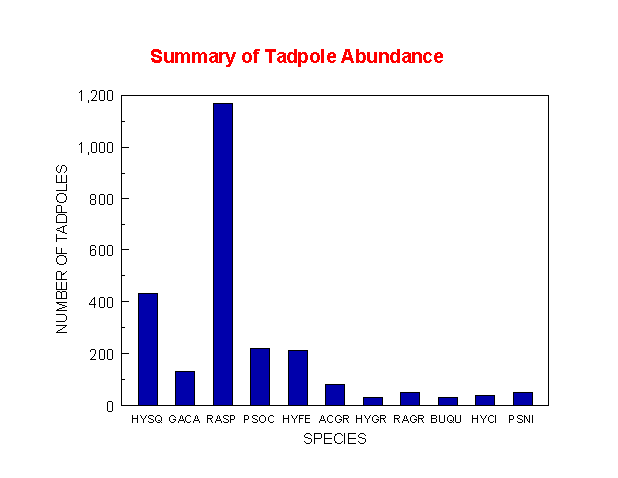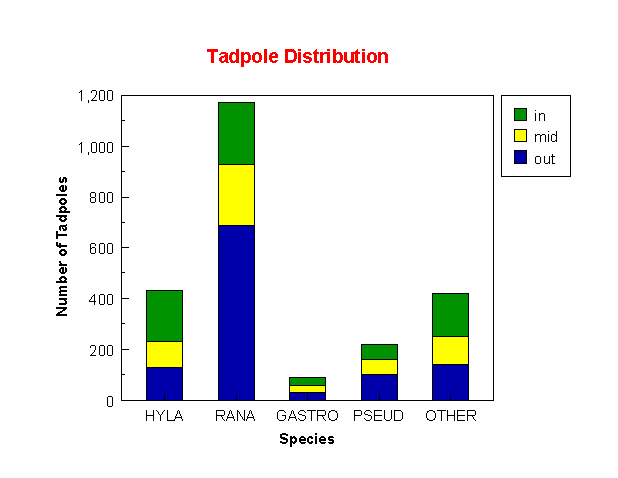
![]()
Back to 1995 Reports
1995 Annual Research and Extension Report
Microhabitat and Predator-Prey Relationships: Examination of Interactions between Anuran Larvae and Aquatic Insects
George W. Tanner and Kimberly J. BabbittDepartment of Wildlife Ecology and Conservation
OBJECTIVES
1. To determine the spatial and temporal patterns of use of wetlands modified by drainage, by anurans and aquatic insects.2. To determine experimentally the role of habitat heterogeneity in mediating predator-prey interactions between larval anurans and aquatic insect predators.
BACKGROUND
Wetland loss and modification can have large impacts on anuran
populations. Loss of wetland breeding sites has obvious consequences for
species viability; however, the effect of wetland alteration is less clear
and poorly documented. Activities related to cattle ranching, such as
changes in local drainge patterns and consequent modification of wetland
hydrology can affect species composition of both plants and animals, and
can therefore lead to alteration in habitat structure as well as predator
communities.
Our ongoing research at the MacArthur AgroEcology Research Center
focuses on the spatial and temporal patterns of anuran and aquatic insect
use of wetlands and their relationship to wetland hydrology. In addition,
because plant communities change along hydrologic gradients, we focus on
the relationship between physical attributes of wetlands (i.e., plant
cover, biomass, water depth) and their relationship to anuran numbers and
biomas. This field research is complimented by a series of experimental
manipulations designed to address specific questions regarding
predator-prey interactions and the importance of habitat complexity in
mediating such interactions.
METHODOLOGY
Twelve ephemeral wetlands are sampled every 3 weeks throughout the entire year. Sampling is conducted with a 0.5m x 0.5m x 0.67m open-ended box trap. Within each wetland, sampling is stratified such that 3 replicate, random samples are obtained from each of 3 water depth zones. Nine samples (3 per zone) are taken at each wetland, so when all wetlands contain water, 108 samples (12 wetlands x 9 samples) are collected per sampling period (i.e., 1 week period, every 3 weeks).
Physichemical parameters are measured to characterize microhabitat. Dissolved oxygen, temperature (surface and bottom) and pH are measured in proximity to the trap. Water depth is measured within each trap. Hydroperiod of each wetland is monitored with a permanent marker located at the center of the wetland. Vegetation is characterized by total percent cover, relative abundance of each species, and wet-weight biomass.
All anuran larvae, macroinvertebrates, crustaceans, and fish are collected from each trap using a bar seine. The box is swept (after being cleared of vegetation) for individuals until three consective sweeps yield no additional captures. The information obtained form each trap includes total number of individuals by species and species richness. Total biomass and stage of development for all anurans are dtermined to assess ontogenetic changes in microhabitat use.
Experimental studies are conductd in field enclosures, wading pools adn smaller contains (i.e., aquaria or plastic dishpans). Field experiments are conducted in a totally fenced wetlands to exclude cattle and feral hogs using 28, 0.9m x 0.9m x 0.67m enclosures constructed of wooden frames and fiberglass window screening. Enclosures have tight fitting, but removable tops, and bottoms made of heavy duty plastic. The experiments are conducted as factorial designs with spatially-clumped replicated to all treatments. The enclosures are placed in areas of equal water depth in spatial blocks.
An example of a field experiment is a 2x2x2 factorial design with 2
density levels (20 versus 40 individuals) crossed with high and low levels
of vegetation (based of field estimates of biomass) crossed with presence
or absence of an early-instar, odonate predator. Metamorphosing tadpoles
are collected and age, weight,and size at metamorphosis, as well as percent
survival are recorded.
ACCOMPLISHMENTS
Eighteen sampling trips have been conducted yielding 1600 samples. Wihth
the exception of the aquatic insects, all components of the 1600 samples
have been processed and entered into computer databases. Aquatic insect
samples are currently being processed.
Several manipulative experiment were conducted this year. They are:
Summer:
-
1. Wading pool experiment to assess intra-and interspecific competition
between the squirrel treefrog (Hyla squirella) and the narrowmouth toad (
Gastrophryne carolinensis).
-
1. Field experiment to examine the effects of cover, density, and predator
presence on growth survival in the southern leopard frog (Rana
sphenocephala).
-
2. Wading pool experiment to examine the effects of cover level and
predator size on growth survival in the southern leopard frog.
-
3. Laboratory experiment to assess the effect of nonlethal exposure to an
odonate predator on growth and behavior of the southern leopard frog.
A proposal was submitted to the Florida Nongame Wildlife Program.
Publications:
Babbitt, K. 1995. Bufo terrestris (southern toad) Oophagy. Herpetological
Review. 26:30.
Babbit, K.J. and F. Jordan. in press. Predation on Bufo terrestris
tadpoles: effects of cover and predator identity. Copeia.
Babbit, K.J. submitted. Responses of little grass frog tadpoles (Pseudacris
ocularis) to lethal and nonlethal exposure to an odonate predator.
Herpetologica.
Additional Research: As indicated in the methods section, we
collect fish and crustaceans in addtion to anurans and aquatic insects.
Although information on spatial and temporal dynamics of these two groups
is outside the scope of this project, we continue to collect these data
because they will provide additional imformation regarding the effects of
wetland ditching on the biological components of wetlands in an
agricultural setting. As is the case for anurans and aquatic insects, such
data are generally not available. Thus, in total, the inforamation obtained
from our research will provide a valuable increase in total, the
information obtained from our research will provide a valuable increase in
knowledge of the relationship between wetland hydroperiod and anuran
species breeding associations, the influence of wetland hydroperiod on
seconday biomass productivity in wetlands, and the importance of habitat
features to tadpole survival. This information is currently unavailable,
and our research constitutes the filling of an important gap in our
understanding of these issues. Moreover, information from this project can
be used to direct restoration activities relative to amphibian and wetland
management.
FUTURE PLANS
Field sampling will continue through October 1995. In addition, the
following experiments will be conducted:
-
1.Field experiment to assess the effects of cover in mediating
predator-prey interactions using the squirrel treefrog.
-
2.Wading pool experiment ot assess effects of cover and prey alternative (narrowmouth
toad) in mediating predator-prey interactions using the squirrel treefrog.
-
3.Laboratory experiment to assess behavioral responses of narrowmouth
toads asnd squirrel treefrogs to predators. (This will provide important
information relative to the importance of behavioral machanisms as an
explanation for the above experiment).
-
4. Commplete project and graduate Kimberly Babbit in May (August) 1996.



2001 Southern DataStream